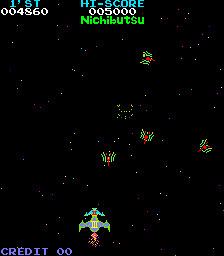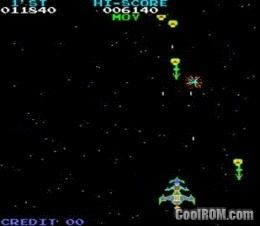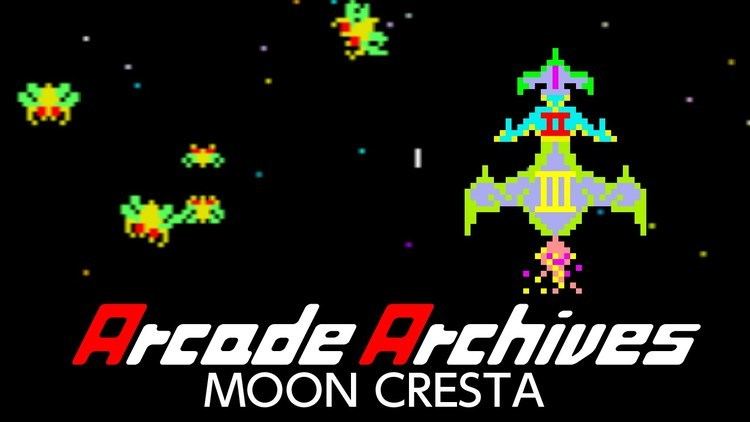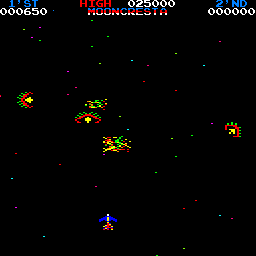7.6 /10 1 Votes
3.5/5 Google Play Cabinet Upright, Cocktail Initial release date May 1980 Series Oretachi Gēsen Zoku | Designer(s) Shigeki Fujiwara CPU Z80 (@ 3.072 MHz) Developer Nihon Bussan | |||||||||||||||||||||||||||||||||
Mode(s) Two players alternating turns Arcade system Namco GalaxianSega Z80 Sound Tone generator and discrete circuits Platforms Arcade game, PlayStation 4 Similar Oretachi Gēsen Zoku games, Taito games, Shoot 'em up games | ||||||||||||||||||||||||||||||||||
Arcade longplay 417 moon cresta
Moon Cresta (ムーンクレスタ) is an arcade game released in 1980 by Nichibutsu. A moving starfield gives the impression of vertical scrolling, but the game is a fixed shooter in the vein of Namco's Galaxian.
Contents
- Arcade longplay 417 moon cresta
- Moon cresta 1980 nichibutsu mame retro arcade games
- Gameplay
- Critical reception
- Variations
- Legacy
- High Scores
- References

Incentive Software published a version of this arcade game for many 8-bit home computers of the time. Dempa also released a port of both Moon Cresta and Terra Cresta for the X68000. It was also released on the Wii Virtual Console in Japan on March 9, 2010 and PlayStation 4(Arcade Archives) in 2014.

Moon cresta 1980 nichibutsu mame retro arcade games
Gameplay

The player begins the game with a small spaceship armed with a single laser cannon. After successfully completing the first four waves of alien attacks, the player must attempt to dock his ship with the next 'stage' of the ship. This second stage has two lasers in addition to the original one. (Each docked stage is one of the player's "lives". This concept of docking two "lives" together to increase firepower would later reappear in Galaga.)

After successfully clearing two more waves of aliens, the player must again dock with the third and final piece of the ship which also has two more lasers (giving the player 5 lasers in total). The trade-off for this is that the entire ship is a much larger target. Failure to correctly align the stages during either docking sequence causes the destruction of the stage being docked with.

After completing the first eight waves the player's ship reverts to the first stage and the process is repeated. If any of the player's three ships are lost along the way, the docking sequence occurs only after the first four waves have been completed.
Play ends when all three of the player's ship-stages are destroyed. On the Arcade and MAME versions, if the player reaches a score of 30,000 points he is awarded an extra stack of 3 more ship-stages along with the message Enjoy Another Game if he loses the first set of ship-stages. Most arcade machines had a switch in the cabinet to allow the choice of the free game to be attained at either 30,000 or 50,000 but not both.
Critical reception
The ZX Spectrum conversion, published in 1985 by Incentive Software, was met with average review scores. Your Spectrum awarded two hits out of three: the gameplay was felt to be close to the arcade original, but was showing its age. Sinclair User awarded 3 out of 5 stars, and considered it only worth playing in order to win Incentive's prize for the first person to reach 30,000 points. It was particularly well received by Crash magazine, who awarded it a 'Crash Smash', praising the quality of the conversion.
Variations
The most difficult version of Moon Cresta is the Nichibutsu version since in this version of the game in the Birds waves, the last Bird becomes invisible and Arrow Ships drop with 3 at a time on the first round.
Also on this version, the last alien in each wave becomes faster at the 3rd round compare to round 5 for the Taito/Sega/Gremlin versions.
The following details the main variation differences:
Taito Moon Cresta
Wave 1+2 Eyes hover until several are shot.
Birds 5+6 Birds are never invisible.
Wave 9+10 Arrow Ships start with 1 flying downwards on first round and increase by 1 each round i.e. second time round there are 2 etc. until all 10 fly down at once.
Aliens slow down in waves 1-4 if player killed.
Free game at 30000.
Arrow Ships fly faster at end of wave 4 plus from then on last alien flies faster i.e. round 5.
Similar to Taito is Fantazia with different Sprite colours.
Sega/Gremlin Moon Cresta
Wave 1+2 Eyes do not hover.
Aliens speed up on 3rd round.
2 Arrow Ships drop on first round.
No invisible Birds.
Aliens do not slow down in waves 1-4 if player killed.
Free game 30000.
Centuri Eagle Moon Cresta Clone
Different sprites used throughout but essentially the same as Taito version except aliens speed up on 6th round.
Nichibutsu Moon Cresta
As Gremlin plus: Last Eye on waves 1-4 moves differently
Last Bird is invisible Wave 9+10 Arrow Ships start with 3 flying downwards on first round and increase by 1 each round i.e. second time round there are 4 etc. until all 10 fly down at once.
Arrow Ships fly faster at end of wave 3 plus from then on last alien flies faster i.e. round 4.
Super Moon Cresta
Same as Taito revision only aliens fire 1 bullet with increasing speed each wave plus player ships shoot faster.
Legacy
- Moon Cresta (1980) - The emulated version was re-released in 2005 for PlayStation 2 in Japan as part of the Oretachi Geasen Zoku Sono-series.
- Terra Cresta (1985) - The emulated version was re-released in 2005 for PlayStation 2 in Japan as part of the Oretachi Geasen Zoku Sono-series.
- Dangar - Ufo Robo (1986)
- Terra Force (1987)
- Terra Cresta II (1992, PC Engine)
- Terra Cresta 3D (1997, Sega Saturn)
High Scores
On the Sega/Gremlin (Arcade) version on 29/02/1984 Bill Awalin attained the World Record score of 152,100 points (Verified by Twin Galaxies).
On the Nichibutsu (MAME) version on 16/01/2009 Marcus McHaffie attained the World Record score of 153,490 points (Verified by Twin Galaxies).
